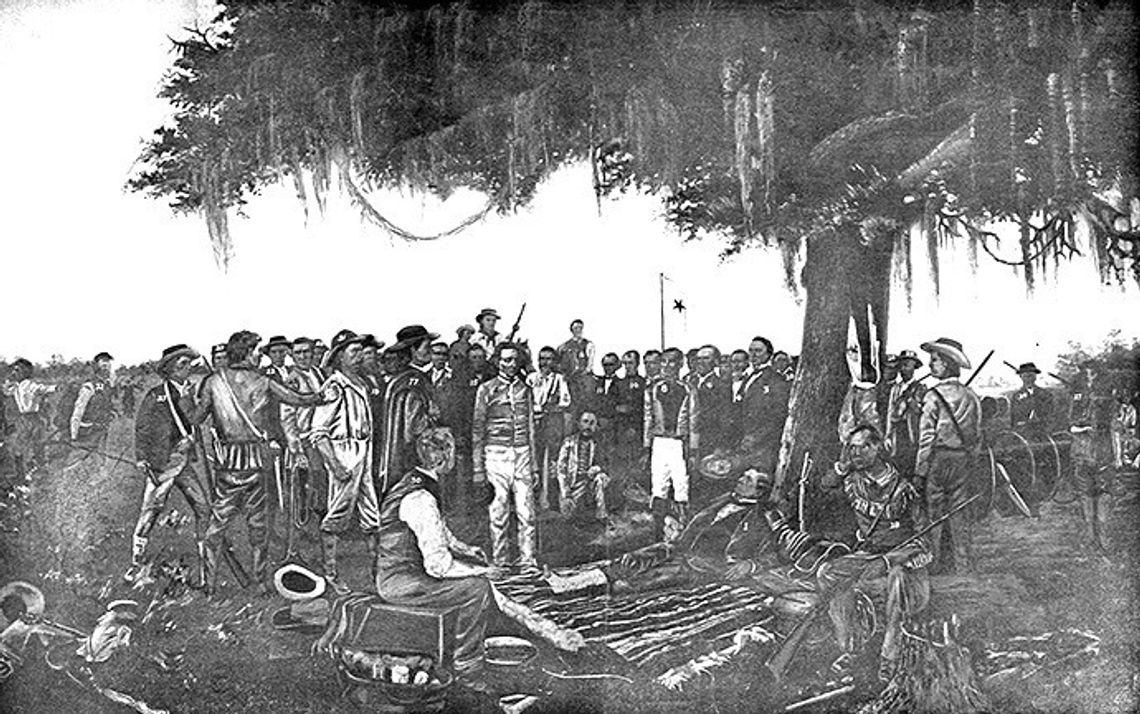FOOTPRINTS OF FAYETTE
You have probably heard of the Battle of San Jacinto and how important this event was to the establishment of the Republic of Texas. We know the facts—the battle was fast, lasting only eighteen minutes in total, while the killing went on for hours.
The following day, April 22, 1836, a group of men left on a patrol to round up stragglers from the fighting the previous day. In this group was Georgia-born Joel Robison, he was the only one in the group who spoke a little Spanish. After riding for some time, they caught sight of a Mexican soldier resting along Vince’s Bayou. The soldier stepped in to a pasture as the Texians approached. He was dressed in a private’s uniform and barefooted.
After some discussion among the Texians, it was decided the soldier should walk to camp to be housed with the other prisoners. As he walked barefooted, the condition of the bottoms of his feet deteriorated. Finally, he turned to the mounted Texians and said he could walk no further and asked be shot where he stood. Some of the group attempted to draw pistols and shoot, but Robison pulled the soldier up on his horse and they continued to camp.
As they rode the two conversed in Spanish about the battle. The captured soldier was surprised at the size of the Texian forces, expecting there to be many more soldiers as the ferocity of the battle was overwhelming. Robison asked why the soldier was fight ing and would he return if asked to do so and he responded, “I was forced into service” and no he would not return. You may remember your Texas history that, as the group rode into camp, the captive Mexicans began to salute the soldier on horseback and exclaim “El Presidente!” This is when Santa Anna asked Robison to get him to Houston immediately.
In the picture above you have likely noted the wounded Gen. Houston resting under the tree and Santa Anna standing. You will also notice two men who are illustrated much higher than the rest in the image. These two men are Joel Robison and James Austin Sylvester and are called out for distinction during these historic few days having found and brought Santa Anna back to camp.
I have given a brief but relevant account of Robison’s involvement in the capture of Santa Anna but I want to share how he is tied to our own Fayette County. Joel Walter Robison was born in Georgia and his sister was married to Stephen Townsend.
This may not seem significant to most, but you are indebted to Townsend and his clan. They, through family and marriage, had the largest representation at the Battle of San Jacinto of any other family—some say over twenty in total. Townsend also established Townsend Settlement near Round Top.
Robison came to Fayette County with the Townsends and settled near what is today known as Florida Chapel Road. Joel was made an Entered Apprentice Mason at Lafayette #34 in La Grange and was raised as a Master Mason in Florida #46 in Round Top.
Robison was one of the first Tex as Rangers as commissioned by President Sam Houston. Robison went on to serve the community in many ways, including in Austin as a Representative.
Robison was also at the Alamo prior to the fateful March 6, 1836 attack which took the lives of so many. He was dispatched from there in late February with a message and returned home to Fayette County afterwards. He and his wife both died here in Fayette County and were buried in Florida Chapel Cemetery before being moved to the Texas State Cemetery in the 1930s. Today under an old oak near a small white building at Florida Chapel, there is a low spot in a small, iron-fenced plot where Joel and his wife were originally laid to rest. Next to that spot lies his friend, Masonic Brother and fellow veteran Stephen Townsend.
I wanted to also mention present at the battle was Anson Jones. He was carrying saddle bags on his horse containing the original three warrants for the first three Masonic Lodges in what became the Republic of Texas which were granted by the Grand Lodge of Louisiana. There is an interesting story about why the Texians went to Louisiana for these Warrants and not Mexico, but I will save this for a later time.
Sources: 1881 Letter of Joel W. Robison in Lotto’s Fayette County, Her History and Her People Walter Freytag’s Robison File in the Fayette Heritage Museum & Archives, La Grange



